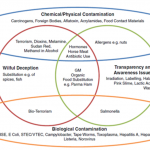Delegates from Food Safety Tech‘s Supply Chain Vulnerabilities left the conference better prepared to face the challenges from the threats to their companies from the global supply chain.
Pat Brown, Senior Director of Food Safety at Rite Aid, who is a Food Safety Tech Advisor and was interviewed for the “What Keeps You Up at Night?” Food Safety Tech article, said to me at this week’s Supply Chain Vulnerabilities Conference in a tongue-in-cheek manner, “Rick, you know what keeps me up now? Your f#@&! conference!”
I know Pat well enough to understand his comment and Pat did not have the monopoly on the word “Fear.” Our intent in developing this conference was not to scare the pants off food safety and quality professionals but to educate them on the threats to their customers and companies from the supply chain and, equally important, introduce some best practices and technology solutions.
Speakers presented supply chain threats to food companies and their customers such as spices from Asia and everything that comes with them such as pesticide residues, bacteria and rocks. Tim Sonntag from Wixon pointed out that spices and seasonings topped FDA’s Reportable Food Registry of salmonella-related entries and explained why traceability is a challenge when sourcing products such as spices from Asia.
Marty Mukenfuss from FDA gave us an update on the Food Safety Modernization Act as well as a rundown of the FY 2011 Imported Food Report. Tatiana Lorca of Ecolab provided a GFSI overview but more importantly, Best Practices of making the best use of GFSI. The case histories that were presented were from big and medium size companies and provided us with real world solutions to better managing supplier risk. The two lawyers in the group, Jack Hall and Marty Ellis were entertaining and enlightening on the legal threats and thus, financial damages of a food safety outbreak caused by a supplier. Also, they discussed the legal ramifications of FSMA and provided available tools to protect the industry.
It’s not just imported food supplies that are threats. Paul Hall of Flying Foods told us of pre-cooked chicken from a domestic supplier that tested 95 percent positive for salmonella and the steps his company took to prevent that.
Pharmaceutical and Medical Device executives have gone to jail when found negligent in product safety issues. With FSMA, FDA has more enforcement power than ever before, which was confirmed by Mukenfuss. Dr. David Acheson, the chairperson of this conference, moderated a panel discussion that included the question “should food executives go to jail if they are knowledgeable and negligent in a food safety outbreak that cased injury to the public?” The consensus from the panel: “Yes!”
Jennifer McEntire of Leavitt Partners gave a fantastic presentation on Traceability and she reviewed the background of an IFT traceability pilot project she is working on. The project was commissioned by FDA to determine what data is needed to trace products and how to make sure it is accurate and quickly accessible. The data is being reviewed by IFT now and will be presented to Congress this summer. Food Safety Tech plans to report on its findings as soon as it is available.
Overall, the presentations led to discussions between speakers, delegates and sponsors. Solutions, tools and best practices were discussed so that fear was not the underlining them of the conference. I would say the takeaways were:
- With more and more global procurement of supplies, it is even more difficult now to produce safe, quality food products;
- FSMA is a game changer for the food industry;
- There are tools, solutions and best practices that can guide you through FSMA compliance as well as protect you from supply chain threats;
- GFSI is a great tool but is not the silver bullet. Also, you need to understand the difference between a good audit and a bad audit; and
- Supply Chain education and understanding is key to protecting your customers and company.
The purpose of the conference was not only to illustrate things that food safety and quality professionals need to be aware of but how to plan for and prevent these threats from harming your customers and company. The conference was successful because delegates left with tools and techniques that they can start using and implementing right away.
At the conclusion of the conference we realized that this subject is much larger and can’t be covered in two days. We are now planning a follow up program for the fall.
All the best!
Rick Biros
Publisher/President






